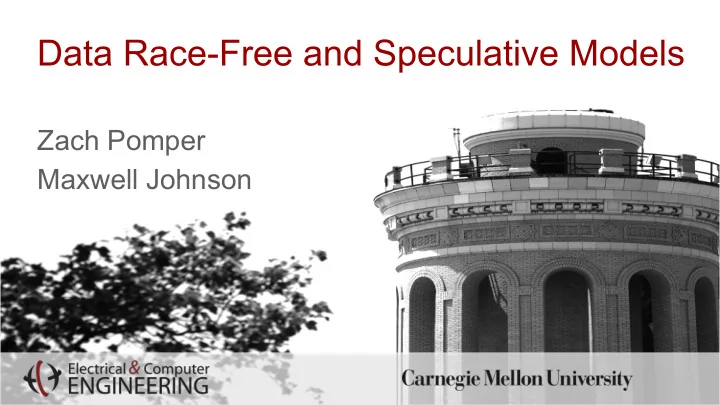

Data Race-Free and Speculative Models Zach Pomper Maxwell Johnson
DeNovo: Data Race-Free Model ▪ Modern consistency provides the programmer too much freedom ▪ “Wild shared memory behaviors” ▪ Requires sophisticated, complicated, high-overhead coherence protocols ▪ Coherence can be simplified by moving complexity to the compiler ▪ Compiler can be simplified by restricting the programmer
Deterministic Software ▪ Deterministic Parallel Java ▪ Static checker guarantees code is deterministic ▪ foreach , dobegin ≡ fork/join, each defines a “phase” ▪ “DPJ guarantees that the result of a parallel execution is the same as the sequential equivalent” ▪ Every memory object assigned to named “region” ▪ Every method annotated with read/write “effects” ▪ This is potentially very conservative ▪ Compiler enforces no interference
DeNovo Protocol ▪ Three states: Invalid, Valid (read access), Registered (write access) ▪ L2 lines hold data or, if line is Registered in some L1, that L1’s ID ▪ Zero directory (registry) overhead ▪ Compiler inserts self-invalidation instructions at the end of a phase ▪ Nice HW optimization: Don’t need to invalidate anything we touched in this phase; we already have the current value (by assumption). ▪ Should only invalidate the region accessed in phase
Refinements/Optimizations ▪ Changing the granularity ▪ Can mark each word as valid/invalid, use merge operations ▪ Byte-level granularity possible, but uncommon, so inefficient ▪ Eliminating indirection ▪ Predict which L1 holds the data, request from that instead of L2 ▪ Mispredicts are NACK’d, which is already part of the protocol ▪ Flexible communication granularity ▪ Communication region table can tell HW how data is structured ▪ Allows prefetching w/o modifying protocol
Storage Cost ▪ L1: 12-25% (authors phrase as “1.5-3% of L2”) ▪ Per-word: 4-8 bits ▪ 2 state bits ▪ 1 touched bit ▪ 1 or 5 (or more?) region bits ▪ L2: 3.5% ▪ 1 bit per word, 2 bits (valid & dirty) per line ▪ Vs. in-cache full map directory: 5 bits/line in L1, N bits/line in L2 ▪ Vs. duplicate tag directories: Associative lookup is not scalable ▪ Vs. tagless directories: 3-5% L1 plus state, more invalidations
Performance MW = MESI word-sized DD = DL w/ (perfect) direct cache-to-cache transfer DW = DeNovo word-sized DF = DL w/ flexible communication granularity ML = MESI line-sized DDF = DL w/ both optimizations DL = DeNovo line-sized DDFW = DW w/ both optimizations
Verifiability ▪ Formal verification on a very small network in DeNovo vs. MESI ▪ Found bugs in both ▪ DeNovo bugs were simple mistranslations ▪ MESI bugs were subtle races ▪ Order of magnitude difference in verification time ▪ DeNovo: 85k states, 9 seconds ▪ MESI: 1,250k states, 173 seconds
A Transaction Memory Model (TCC) ▪ Sequential consistency is slow, weak consistency is difficult to program around ▪ Enter transactions as the memory operation primitive Fundamental principle: ▪ All memory operations now local-only ▪ Operations become visible to other cores only on successful commit ▪ All but one commit fails on conflict, losers retry
Glaring Problems With TCC ▪ Who wins in a given commit conflict? It is difficult to make this decision without starving retries, especially as some commits encompass long instruction sequences ▪ Throughput is exchanged for generality as transactions retry, losing potentially large chunks of work ▪ Long sequences also increase transaction latency, negatively affecting system responsiveness ▪ Commit arbitration requires vast memory bus bandwidth, as conflicting transactions need to coordinate among all cores, i.e. broadcast
Subtler Problems With TCC ▪ Every commit failure will cause a checkpoint rollback -- while this can piggyback off of exception rollback mechanisms, they are typically not designed with performance in mind ▪ Transactions require cache data for each memory operation, this space is potentially unbounded in transaction length ▪ Unclear how to handle numa/exotic interconnects. (It may be prohibitively expensive to wait on some remote cores for commit confirmation/abort.) ▪ Forced to add remote coordination for data-partitioned workloads
Upsides of TCC ▪ Programmers don’t need to be concerned about parallelism. Not even a little bit! ▪ Well okay, all of the usual parallel performance pedagogy still applies, but allowing for longer transactions does allow for the elimination of many/most synchronization primitives. ▪ Cache coherency becomes outmoded, as remote caches no longer need to be coherent -- saves area and implementation complexity ▪ Can reuse existing superscalar mechanisms like instruction windowing to speculate across transaction boundaries
Proposed TCC Implementation ▪ Buffer writes to flush to memory all at once on transaction complete (a commit packet) ▪ Similarly to coherence protocols, snoop the interconnect and check for locally speculated addresses for conflicts with commit packets ▪ Rollback to known-good checkpoint on conflict ▪ Compiler aware of maximum transaction length, but hardware could automatically partition long instruction sequences into sub-transactions ▪ Particular loads/stores could be ‘promised’ to be local-only ▪ Add transaction buffers to do useful work while arbitration is ongoing (expensive)
Simulation Results ▪ Interconnect could be saturated by commit packets at higher core counts ▪ Performance severely degraded (from perf. increase to loss) with increase in commit arbitration latency ▪ Most workloads don’t overflow the maximum transaction length often ▪ Reasonably large transaction buffers are not prohibitively expensive ▪ ~20KB of added buffers for read write histories
TCC Addendum Broadcasts in 2020+: This graph: Probably looks more like this:
Recommend
More recommend